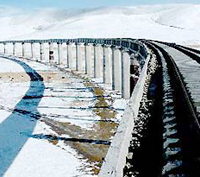
The long-awaited Qinghai-Tibet Railway that will connect Tibet with the rest of China will start trial operations next year.
"The Qinghai-Tibet railway, the world's highest, is to complete track laying by the end of this year and start trials on July 1, 2006," said Minister of Railways Liu Zhijun.
Liu made the remarks during deliberations by deputies from the Tibet Autonomous Region attending the ongoing third plenum of the National People's Congress, China's top legislature.
The railway, hailed as a landmark project in China's plans to develop its western regions, involves a total investment of 26.2 billion yuan (US$3.16 billion).
Construction for the project, which will be the first railway in the region, started in 2001.
The route will begin in Golmud in Northwest China's Qinghai Province and travel to Lhasa, the regional capital. It will be 1,142-kilometres long
"About 960 kilometres of the railway are above 4,000 metres above sea level, with its most elevated sections reaching 5,072 metres above sea level," Liu said.
After it opens, the railway is expected to link Lhasa with Qinghai Province's capital Xining and other major cities such as Beijing, Shanghai in East China, Guangzhou in South China and Chengdu in Southwest China.
The railway project will contribute enormously to the region's economic growth and allow people to travel, said Wang Taifu, an economic researcher from the Tibet Academy of Social Sciences.
"The railway will greatly reduce transport costs for material entering and exiting Tibet, which will help both domestic and foreign enterprises that want to set up in the Tibetan market," Wang said.
Traffic has been one of the major obstacles to economic development of Tibet, which makes up about one-eighth of China's territory and is the only provincial-level region without a single inch of operating railtrack.
More than 95 per cent of the cargo transported in and out of Tibet, and 85 per cent of the passengers, go by road from Qinghai or Sichuan, according to the Ministry of Communications.
Because of high cost of transportation, raw materials in Tibet cannot easily be transported out of the province, and there is a big imbalance in the cargo entering and exiting the region.
"The railway will help relieve the imbalance," Wang said.
Liu Kai, a researcher with the Beijing-based Chinese Academy of Social Sciences, said the railway will also help the tourism industry, as it will help attract more people from both home and abroad.
The railway project has drawn concerns about possible environmental losses because the Qinghai-Tibet Plateau has a vulnerable, high-altitude eco-system. Once vegetation is damaged, it cannot easily be restored.
Targeting such doubts, Liu said the railway has taken into account eco-system protection, with some 8 per cent of the total construction cost - at least 2 billion yuan (US$ 240 million ) - budgeted for ecological conservation, the biggest amount among all China's railway construction projects.
(China Daily March 8, 2005)
|

